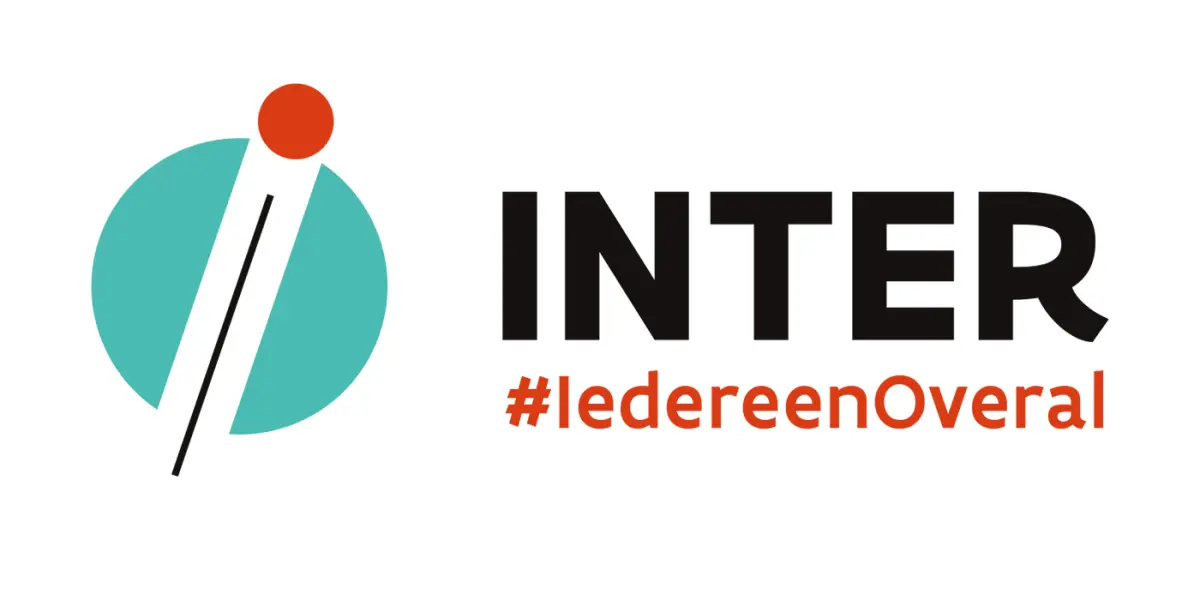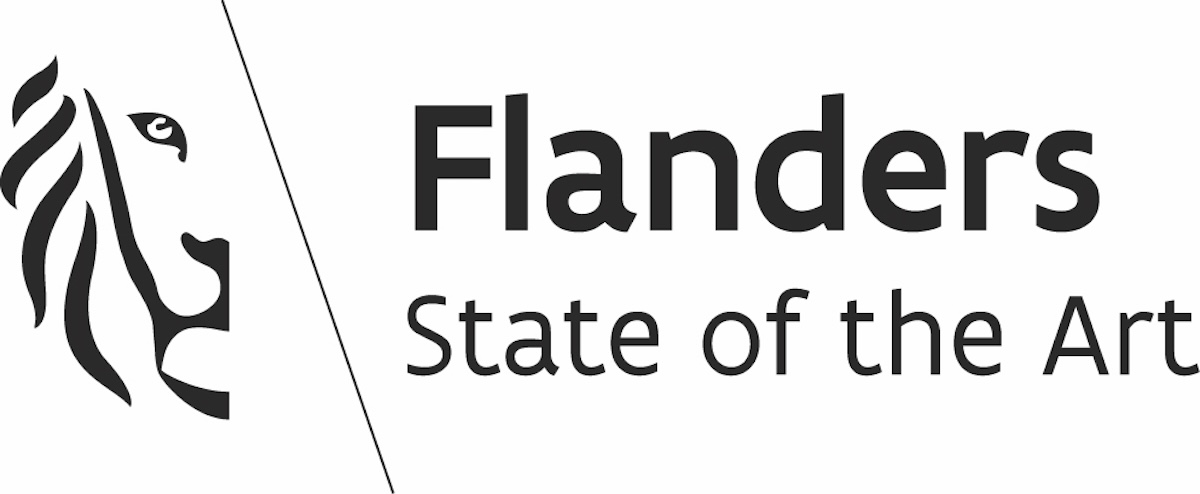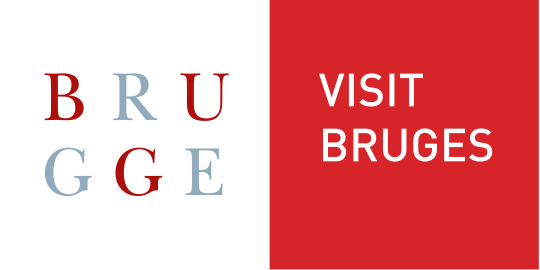Visit and experience: Walk along highlights
This 3.8 kilometre walk takes you past the highlights in the tourist centre of Bruges. Together with a helping of history, fun anecdotes and tips for the best photos along the way. Real quality time for people who enjoy life!
Beforehand
- It is recommended to take a companion with you.
- There is no need to follow the entire walk. Adapt the route to suit your own capabilities and requirements. The dark-orange lines
 on the map are helpful in doing so.
on the map are helpful in doing so.
- You can also shorten the tour by following the indicated marks
 on the map.
on the map.
- Keen to see a particular monument or museum? Use the numbered key locations to find it and head there directly. Please note, we have not included all tourist attractions in the list. You will only find venues that are on or close to the trail.
You will come across the following venues along the way
Off to the start of the walk
The walk begins at Tourist office 't Zand (Concert Hall) ![]() .
Those coming by train will find
accessible toilets
.
Those coming by train will find
accessible toilets ![]()
![]() in the station and you can eat or
drink something at Exki
in the station and you can eat or
drink something at Exki ![]() .
If you still have some questions,
the tourist office Stationsplein
.
If you still have some questions,
the tourist office Stationsplein ![]() will be happy to help
you. You will find the office in
the platform corridor by following the signs towards the ‘Centre’ exit.
will be happy to help
you. You will find the office in
the platform corridor by following the signs towards the ‘Centre’ exit.
Leave the station via the ‘Centre’ exit and cross Stationsplein diagonally to the left. There are lines to guide you from the main exit to the opposite side of the square. These follow the circle of the bus platforms and lead you to the zebra crossing towards the centre. The square itself is covered with level mosaic cobblestones.
Cross the ring road (Buiten Begijnenvest) at the traffic lights and take the path on the left through King Albert I Park. This even granite path takes you to ’t Zand. It is easily accessible and slightly sloping.
1 Concertgebouw Brugge (Concert Hall)
Contact details
't Zand 348000 Brugge
Call 0032 50 47 69 99 (general)
and 0032 78 15 20 20 (ticket line)
E-mail info@concertgebouw.be
Visit www.concertgebouw.be
Accessibility Concertgebouw Brugge (Concert Hall)
Access via the square in front
of the building is sufficiently wide and level. There are various entrances with doors that are wide enough, however, they are manually operated and heavy.
In the entrance hall there is a counter allowing limited wheelchair access. From here, you can easily reach the Concertgebouwcafé ![]() on the ground floor, as well as the Foyer Parterre
(via the lift and slope) on the first floor. The slope is too long and steep to manage comfortably without assistance, however, the lift is easily accessible.
on the ground floor, as well as the Foyer Parterre
(via the lift and slope) on the first floor. The slope is too long and steep to manage comfortably without assistance, however, the lift is easily accessible.
Adapted toilets are located in the entrance hall by the cloakroom (easily accessible except for a few obstacles), at the Foyer Parterre (small, stalls are obstructed by the installation of sanitary vending machines) and in the Lantern Tower (easily accessible).
The Concertgebouw Circuit is partly accessible to wheelchair users. You can therefore request assistance to follow an alternative experience route using an iPad. This features the elements along the regular trail that you would otherwise miss out on. There is an audio guide, but no audio description. Some of the visit is dedicated to sound and music. If you are deaf or hard of hearing there is a sensory chair, a listening device in which sound is felt as well as heard.
Start of the walk
On the ground floor of the
Concertgebouw Brugge (Concert Hall) ![]() you will find the Concertgebouwcafé
you will find the Concertgebouwcafé ![]() and a tourist office
and a tourist office ![]() . Stand with your back to the entrance of
the tourist office and cross the square diagonally to the left towards the pavilion of the underground car park. There is also an accessible toilet
. Stand with your back to the entrance of
the tourist office and cross the square diagonally to the left towards the pavilion of the underground car park. There is also an accessible toilet ![]() here. A line will guide you from the corner of the Concertgebouw towards the square.
here. A line will guide you from the corner of the Concertgebouw towards the square.
Go past the pavilion and continue straight on a little further across ’t Zand Square. Keep the restaurants and cafes on your right. Then go right at the first street, called Zuidzandstraat. Stay on the right along this shopping street. When crossing the first side street you will need to cross two small kerbs ![]() . A little further along, turn right into Sint-Salvatorskerkhof. At this crossroads, opposite Zuidzandstraat you will find
a Panos
. A little further along, turn right into Sint-Salvatorskerkhof. At this crossroads, opposite Zuidzandstraat you will find
a Panos
![]() ,
where you can
grab a tasty takeaway. To visit the step-free and accessible St Saviour’s Cathedral
,
where you can
grab a tasty takeaway. To visit the step-free and accessible St Saviour’s Cathedral ![]() ,
cross Sint-Salvatorskerkhof diagonally to the left.
,
cross Sint-Salvatorskerkhof diagonally to the left.
2 St Saviour’s Cathedral
Contact details
Steenstraat8000 Brugge
Call 0032 50 33 61 88
E-mail info@sintsalvator.be
Visit www.sintsalvator.be
Accessibility St Saviour’s Cathedral
The square in front of the cathedral is designed with stairs. At the top of the stairs
a studded warning strip has been installed. At the side of Sint-Salvatorskerkhof an obstacle-free slope takes you to the entrance of the cathedral.
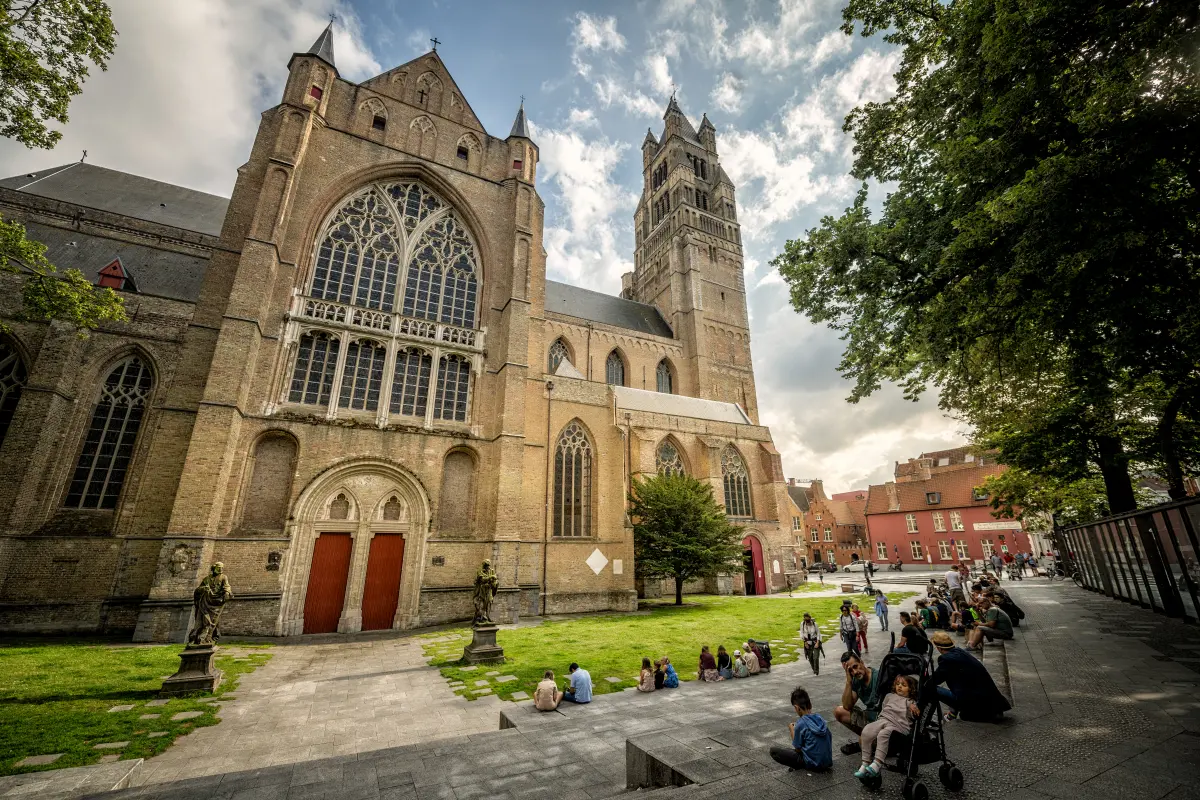
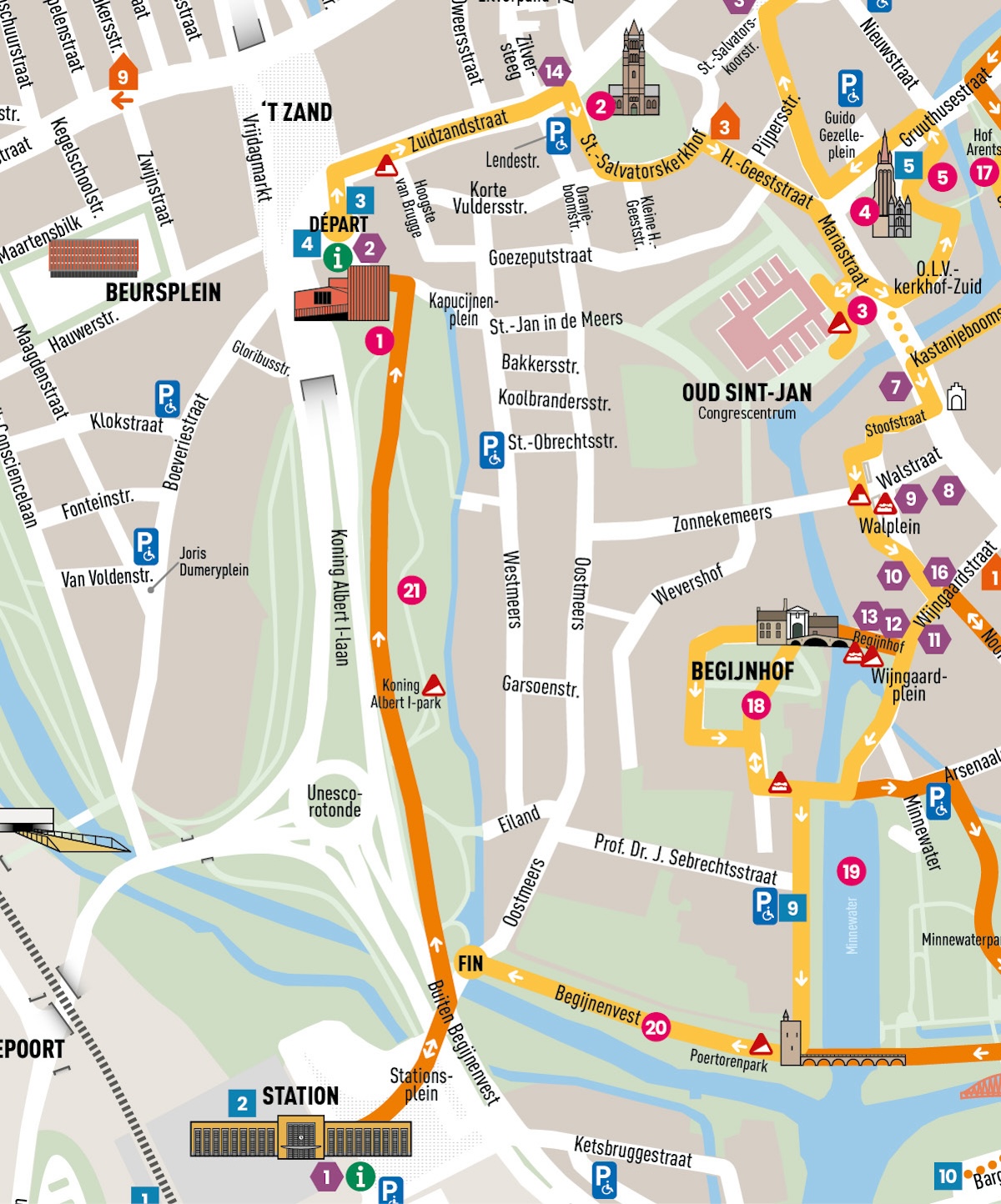
And off you go
From St Saviour’s Cathedral, continue the trail via Sint- Salvatorskerkhof. Go along the back of the cathedral – there are several quiet benches here – and take the third street on the right, Heilige Geeststraat. Stay on the right- hand side and at the end, when you reach the foot of the Church of Our Lady, turn right again, into Mariastraat. Keep following Mariastraat on the right-hand footpath, until you notice a passageway on your right. Turn into this passage, into Eleonora Verbekehof, on the Old St John site.
3 Museum St John’s Hospital
Contact details
Mariastraat 388000 Brugge
Call 0032 50 44 87 11
E-mail musea@brugge.be
Visit www.museabrugge.be
Accessibility Museum St John’s Hospital
St John’s Hospital is easily accessible to wheelchairs and most halls can be reached, also thanks to a spacious lift and a second small platform lift (providing access to one hall). The lifts are equipped with buttons which are marked in relief. You will probably need some help on several slopes which are a little too steep and in managing a heavy door. The exhibited material is easy to view. Help will probably be necessary in the adapted toilet due to limited space and a wall bracket that is in the wrong place. As from autumn 2023, there will be a free audio tour in various languages, which you can follow using your own smartphone or tablet. By scanning QR codes, you can hear an explanation on your device. So be sure to take a headset or earphones along with you.
You can reach the cloister which accommodates the hospital pharmacy via the Eleonora Verbekehof. This square with little traffic and a surface of flat cobbles is easily accessed via the covered passageway in Mariastraat. The entrance to the cloister can be found between some herb borders which have a neat border. A ramp has been provided in the cloister, allowing access across the two steps towards the hospital pharmacy.
And off you go
In order to see the contemporary work of art ‘The veins of the convent’ by Giuseppe Penone
at the Old St John site, stand on Eleonora Verbekehof facing the Medieval infirmary wards, with the passage to Mariastraat on your left. Turn to the right and
go around the corner to the left. You now go down a slight slope ![]() . The work of art is just a few metres further on, literally
in front of the door of the
former convent and behind
the infirmary wards of
St John’s Hospital
. The work of art is just a few metres further on, literally
in front of the door of the
former convent and behind
the infirmary wards of
St John’s Hospital ![]() .
.
Retrace your steps, in order to leave the Old St John site: return along Eleonora Verbekehof and then go straight ahead, into the covered passage leading to Mariastraat. In Mariastraat,
turn right. At St John’s
Hospital ![]() cross the street to
the O.L.V.-kerkhof-Zuid.
Follow this street until you
reach the Boniface Bridge.
The bridge cannot be crossed due to the steps with cobbles, however, beside the bridge
you can enjoy the picturesque surroundings with the
Church of Our Lady
cross the street to
the O.L.V.-kerkhof-Zuid.
Follow this street until you
reach the Boniface Bridge.
The bridge cannot be crossed due to the steps with cobbles, however, beside the bridge
you can enjoy the picturesque surroundings with the
Church of Our Lady ![]() and
the Gruuthuse Museum
and
the Gruuthuse Museum ![]() .
.
And off you go
From Boniface Bridge, between the Church of Our Lady and the Gruuthuse Palace, there is a narrow path that leads you to the front and entrance of these monuments. On your right, you will see the modern reception pavilion of Musea Brugge,
that is accessible to wheelchair users. This is where you buy your tickets for the Museum of
the Church of Our Lady ![]() and
the Gruuthuse Museum
and
the Gruuthuse Museum ![]() .
Along the underpass of
the pavilion you can access
the inner courtyard of the Gruuthuse Palace and the adapted toilet
.
Along the underpass of
the pavilion you can access
the inner courtyard of the Gruuthuse Palace and the adapted toilet ![]() at the Gruuthuse Museum. A comfort strip between the cobbles makes it easy for you to cross the square. You leave the square through the gate on
the other side.
at the Gruuthuse Museum. A comfort strip between the cobbles makes it easy for you to cross the square. You leave the square through the gate on
the other side.
4 Museum of the Church of Our Lady
Contact details
Mariastraat8000 Brugge
Call 0032 50 44 87 11
E-mail musea@brugge.be
Visit www.museabrugge.be
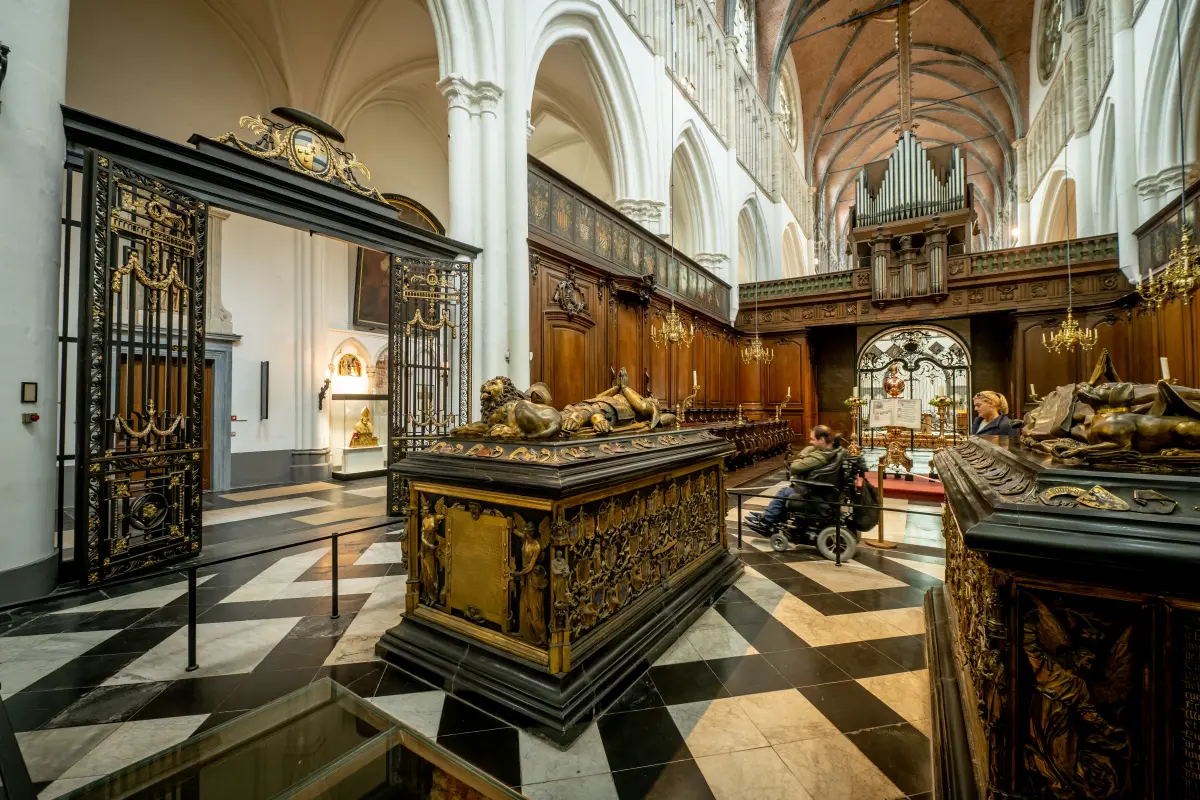
Accessibility Museum of the Church of Our Lady
The entrance to the Museum
of the Church of Our Lady is located on the side of Guido Gezelleplein where you will also find two special parking bays. The entrance has steps and
a rather steep slope ![]() where
you will certainly need some assistance. The nave of the church is easily accessible, although help can be handy for a number of slopes, for example, to reach the tombs. A sensory station has been installed in the church. Blind or visually impaired visitors can touch a 3-D print of the statue ‘Madonna and Child’, feel the cold Carrara marble from which the statue is carved and discover the altar upon which the statue stands.
where
you will certainly need some assistance. The nave of the church is easily accessible, although help can be handy for a number of slopes, for example, to reach the tombs. A sensory station has been installed in the church. Blind or visually impaired visitors can touch a 3-D print of the statue ‘Madonna and Child’, feel the cold Carrara marble from which the statue is carved and discover the altar upon which the statue stands.
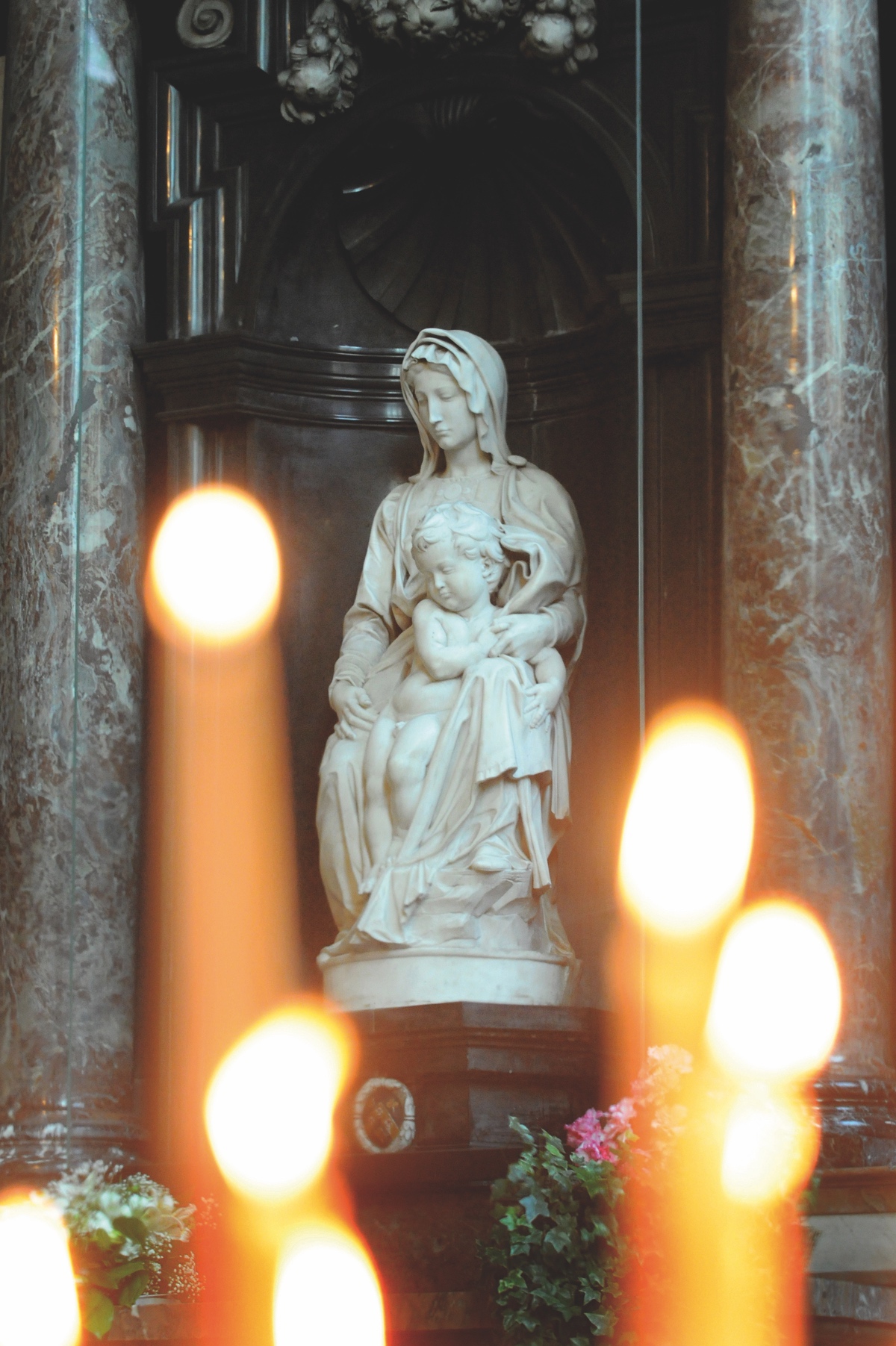
5 Gruuthuse Museum
Contact details
Dijver 17C8000 Brugge
Call 0032 50 44 84 11
E-mail musea@brugge.be
Visit www.museabrugge.be
Accessibility Gruuthuse Museum
The Gruuthuse Museum is not accessible to wheelchair users because the historic building has many complex differences in floor level. Even so, the museum is keen to be as inclusive as possible. For visitors with a visual impairment, there are models, replicas and other tactile objects to appeal to the senses, plus
an adapted explanation in the audio guide. For visitors with
a hearing impairment, sound fragments have been replaced by alternatives, such as subtitles and texts. A visioguide in Flemish sign language and International Sign (IS) tops off a visit. Along
the underpass of the reception pavilion you can reach the adapted toilet ![]() at the Gruuthuse Museum.
at the Gruuthuse Museum.
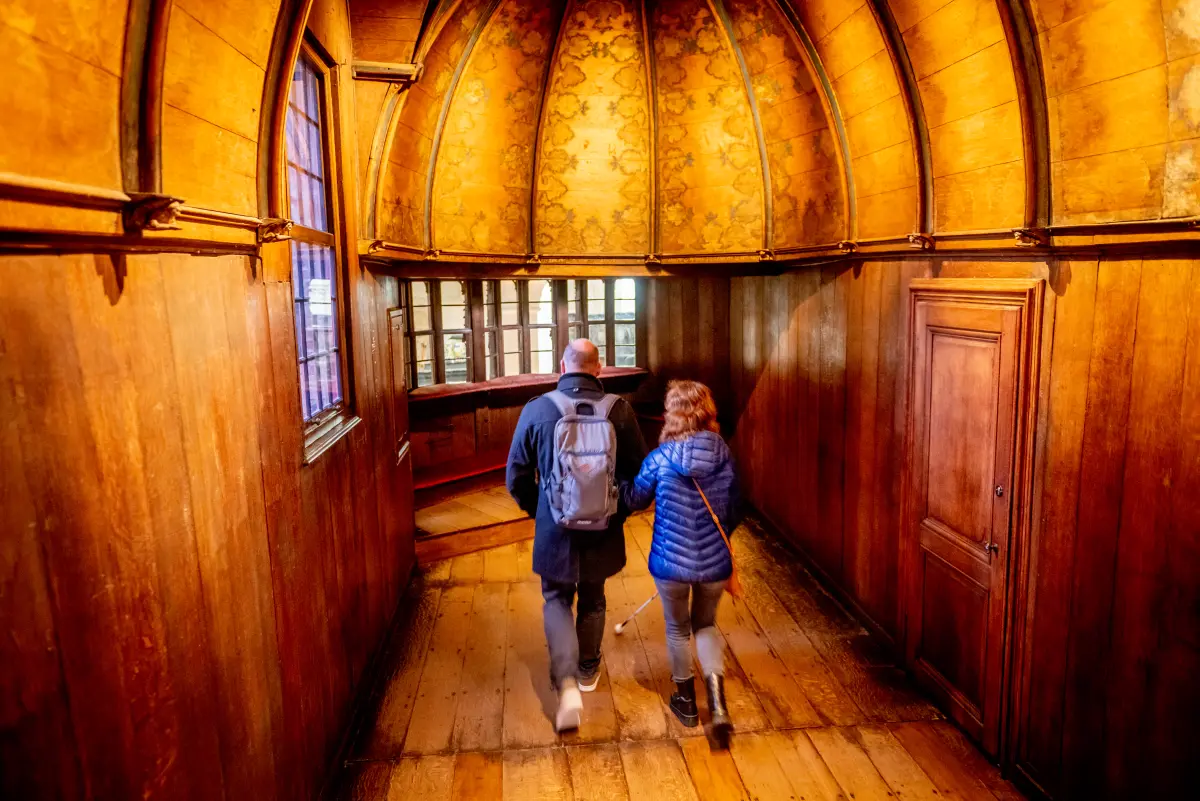
And off you go
Leave the inner courtyard of the Gruuthuse Museum by the gate, turn left into Gruuthusestraat and stay on this side of the street for a few metres until just before the Church of Our Lady. Then, cross over to Guido Gezelleplein, which has flat cobble paving and some benches for a rest. Once you have crossed, turn left, go past the restaurants and immediately take the first street to the right. This is Mariastraat, which takes you to Simon Stevin Square.
At the end of Mariastraat, turn right into Oude Burg. Simon Stevin Square is now on your left. The square is covered with mosaic cobblestones.
The terraces in the middle of
the square are bordered with planter boxes and there are bicycle racks between the terraces. Not all terraces on
the edges of the square have
a border. There is a gutter on
the left and the right of the central area. Benches on the square are best accessed
from the Steenstraat direction.
On Simon Stevin Square the bakery-restaurant Le Pain Quotidien ![]() is open all day long.
is open all day long.
To continue the trail, continue along the right side of Simon Stevin Square. While you are still on the square, turn right into an alley, called Loppemstraat.
Go along this alley and when you reach the end, turn left into Oude Burg. Unless you fancy
a snack or a drink in De Verbeelding ![]() , in which case
turn right.
, in which case
turn right.
Stay on the left-hand side of Oude Burg, where after a while the footpath narrows ![]() to 70 centimetres. If this creates an obstacle for you, cross Oude Burg diagonally right towards the lowered footpath on the other side and continue to the left. You can cross the street diagonally again immediately past the bicycle racks or a little further along at Kartuizerinnenstraat. Now you are able to reach the City Halls
to 70 centimetres. If this creates an obstacle for you, cross Oude Burg diagonally right towards the lowered footpath on the other side and continue to the left. You can cross the street diagonally again immediately past the bicycle racks or a little further along at Kartuizerinnenstraat. Now you are able to reach the City Halls ![]() .
.
TIP: Pop along the Kartuizerinnenstraat to visit
the Military Chapel and Bourgogne des Flandres Brewery ![]() . On the right of the street the footpath is very narrow (83 centimetres) when reaching the planted area. The footpath on the left is easily accessible until the bend. Bourgogne des Flandres is just beyond the bend on
the right-hand side. To continue the trail, return
to Oude Burg. Here, you cross diagonally towards the
City Halls
. On the right of the street the footpath is very narrow (83 centimetres) when reaching the planted area. The footpath on the left is easily accessible until the bend. Bourgogne des Flandres is just beyond the bend on
the right-hand side. To continue the trail, return
to Oude Burg. Here, you cross diagonally towards the
City Halls ![]() .
.
Go under the gallery of the City Halls to reach the gate to access the inner courtyard of the City Halls. Here, you have a wonderful view of the Belfry and by crossing the inner courtyard
you end up on the Market Square.
6 Bourgogne des Flandres
Contact details
Kartuizerinnenstraat 68000 Brugge
Call 0032 50 33 54 26
E-mail visits@bourgognedesflandres.be
Visit www.bourgognedesflandres.be
Accessibility Bourgogne des Flandres
There are no steps when entering the brewery via the entrance of the brasserie. The adapted toilet can be accessed using the lift. In the exhibition area there are several slopes. Ramps and mobile sloping ramps make it easier to get around, but you will still require some assistance. The outdoor terrace is also accessible to wheelchairs and they fit nicely under the tables. The terrace beside the water is not accessible to wheelchair users.
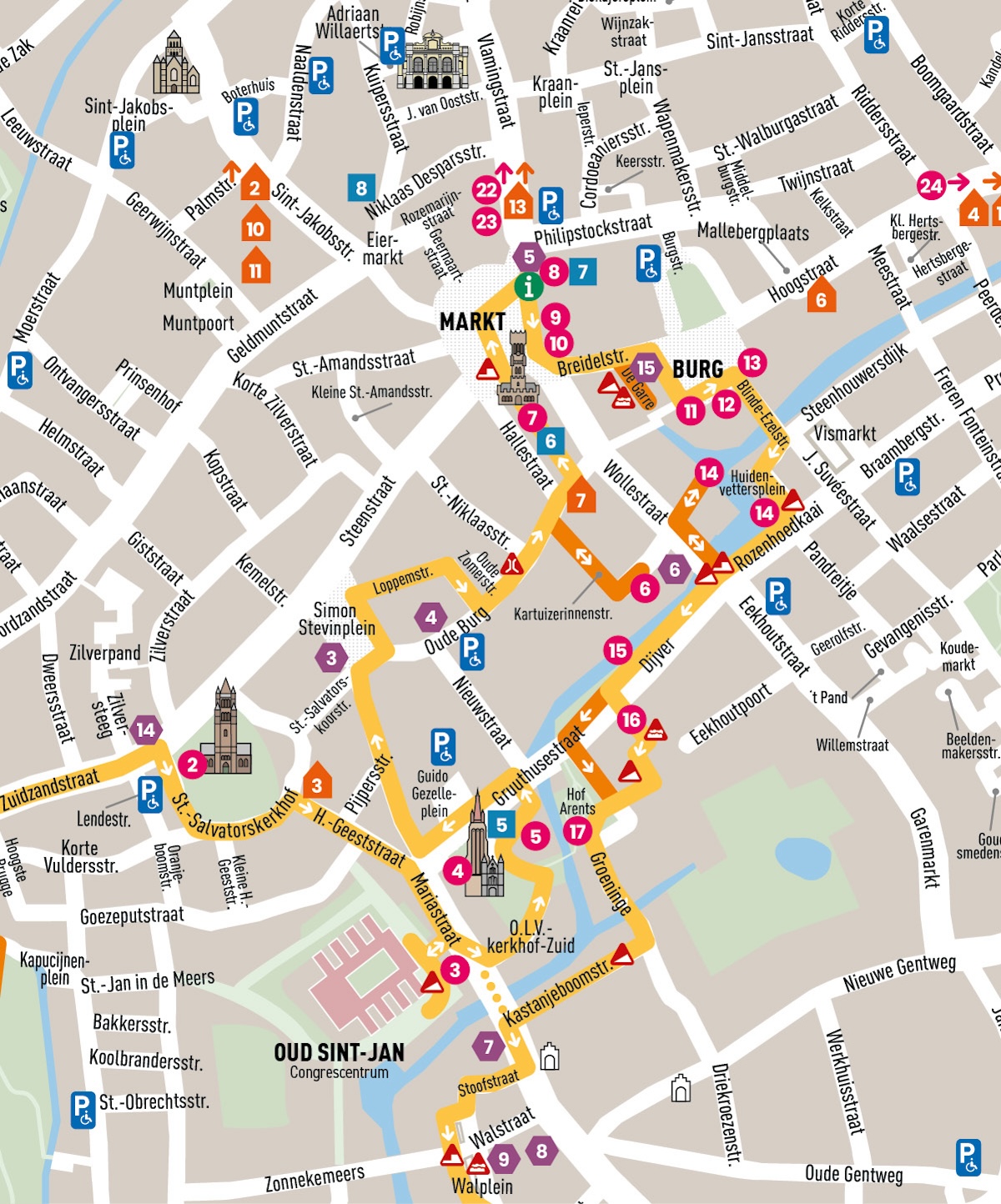
Exploring the Market Square
The Market Square is one of
the central squares in the city.
It features easily accessible mosaic cobblestones. The many terraces are situated around
the sides and most of the year they are enclosed with planter boxes. On the middle square, around the statue of Bruges’
folk heroes Jan Breydel and Pieter De Coninck, there are
a number of benches. With your back to the Belfry ![]() , and after passing a 3-cm high kerb
, and after passing a 3-cm high kerb ![]() , you can cross the Market Square diagonally to the right to get to the Historium Brugge
, you can cross the Market Square diagonally to the right to get to the Historium Brugge ![]() . In the same building, you will also find a tourist office
. In the same building, you will also find a tourist office ![]() and the Duvelorium Grand Beer Cafe
and the Duvelorium Grand Beer Cafe ![]() .
.
From the Historium Brugge,
turn left and we recommend staying on the left to pass
first the Provincial Court ![]() then, on the corner with Breidelstraat, the building
which accommodates Bruges Beer Experience
then, on the corner with Breidelstraat, the building
which accommodates Bruges Beer Experience ![]() .
On this side of the Market Square, a row of detectable, smooth stones has been laid, which you can use as a guide. Both on the Market Square and nearby you will find an accessible toilet
.
On this side of the Market Square, a row of detectable, smooth stones has been laid, which you can use as a guide. Both on the Market Square and nearby you will find an accessible toilet ![]() on the inner courtyard of the City Halls,
an accessible toilet
on the inner courtyard of the City Halls,
an accessible toilet ![]() in Historium Brugge
in Historium Brugge ![]() or a ‘changing place’ in the Provincial
Court
or a ‘changing place’ in the Provincial
Court ![]() (as from spring 2024).
(as from spring 2024).
7 Belfry and City Halls
Contact details
Markt 78000 Brugge
Call 0032 50 44 87 11
E-mail musea@brugge.be
Visit www.museabrugge.be
Accessibility Belfry and City Halls
The Belfry is not accessible to wheelchairs, but the City Halls are. The path to enter the City Halls and the inner courtyard
are covered in flat cobblestones. There is an easily accessible toilet ![]() on the inner courtyard. The Garemijn hall is the most accessible of all. The halls on the upper level are reached by lift, but help may be necessary to manage some steeper slopes and in the narrow pass when leaving the lift on the first floor.
If you come from Garemijn hall, you will find a sensory model with information in Braille on
the Market Square, on the left
in front of the building and between the benches.
on the inner courtyard. The Garemijn hall is the most accessible of all. The halls on the upper level are reached by lift, but help may be necessary to manage some steeper slopes and in the narrow pass when leaving the lift on the first floor.
If you come from Garemijn hall, you will find a sensory model with information in Braille on
the Market Square, on the left
in front of the building and between the benches.

8 Historium Brugge
Contact details
Markt 18000 Brugge
Call 0032 50 27 03 11
E-mail info@historium.be
Visit www.historium.be
Accessibility Historium Brugge
The Historium Brugge has alternative access with a lift.
Go straight on as you enter the entrance hall, and just before reaching the inner courtyard
you will find the lift on the left in
a small hall. An alternative route and assistance is provided
for wheelchair users at the attraction ‘Historium Story’, since you are required to take the lift
in certain places. The sporadic cobblestones along the way are
an easy ride. The accessible toilet ![]() has plenty of room and rails, only there is limited room beside the door handle on the inside. The texts at this attraction are very small, and not legible
for everyone, however, thanks to an audio guide you can hear everything in your own language (ten languages available).
A hearing loop is provided for
the hard of hearing.
has plenty of room and rails, only there is limited room beside the door handle on the inside. The texts at this attraction are very small, and not legible
for everyone, however, thanks to an audio guide you can hear everything in your own language (ten languages available).
A hearing loop is provided for
the hard of hearing.

9 Provincial Court
On the site where this neo-Gothic Provincial Court now stands, there was once the iconic Water Hall (a Gothic maritime warehouse) between the 13th and the 18th century, and then in the 19th century a monumental neo-classical housing complex. The provincial council held meetings in the Provincial Court until 1999, but it is currently being converted into a proverbial gate to the province. Once the building is ready, you will be able to discover all about the many wonders of the province of West Flanders, including Bruges, as provincial capital. The building’s historic past will also be highlighted.
Contact details
Markt 38000 Brugge
E-mail provinciaalhof@west-vlaanderen.be
Visit www.provinciaalhof.be
Accessibility Provincial Court
Until spring 2024, the Provincial Court will be undergoing thorough restoration, renovation and refurbishment, which means the building will be closed to visitors. Once it reopens, the building will be accessible to everyone. Beside the wide staircase on the Market Square, there will be a new lift for wheelchair users. Inside the building, a second accessible lift will provide access to every floor. The new sanitary units will be fitted with adapted toilets and a spacious and comfortable ‘changing place’, including room for assistance. The visitor experience will also be appropriate for everyone, featuring adapted information channels, furniture where wheelchairs fit underneath, and high and low-level experience elements.

And off you go
On the corner of the Market Square and Breidelstraat, turn left in the direction of Burg Square. At the turn there are concrete poles with chains in between. To avoid these, keep as left as you can on the Market Square. The entrance to the
Bruges Beer Experience ![]() , which is inaccessible to wheelchairs, is directly after
the turn into Breidelstraat on your left-hand side.
, which is inaccessible to wheelchairs, is directly after
the turn into Breidelstraat on your left-hand side.
Half-way on your right you will see a narrow alley, called De Garre. It is just wide enough
(77 centimetres) to go in.
The alley slopes ![]() steeply downwards and is covered with very bumpy cobblestones. Just beside the entrance to the alley you will find Chez Albert
steeply downwards and is covered with very bumpy cobblestones. Just beside the entrance to the alley you will find Chez Albert
![]() ,
a takeaway for Liege waffles.
,
a takeaway for Liege waffles.
10 Bruges Beer Experience
Contact details
Breidelstraat 38000 Brugge
Call 0032 50 69 92 29
E-mail info@mybeerexperience.com
Visit www.mybeerexperience.com
Accessibility Bruges Beer Experience
The museum is inaccessible to wheelchairs. If you are blind or have a visual impairment you can listen
to all the texts on a tablet.
The iPad is handed over
with two headsets, allowing visitors who are blind
or visually impaired to experience the attraction together with a companion. For visitors with a hearing disability, a translation into Flemish sign language is available.

Exploring Burg Square
When you reach Burg Square, turn right immediately, because in the right corner of the
square you will find the famous Basilica of the Holy Blood ![]() .
The City Hall
.
The City Hall ![]() stands on the
left and in the middle. The building in white with gold
next door is the Civil Registry, with access to the Liberty
of Bruges
stands on the
left and in the middle. The building in white with gold
next door is the Civil Registry, with access to the Liberty
of Bruges ![]() in the corner. Burg Square is covered in flat mosaic cobblestones. Benches are provided at the Liberty of Bruges. St Donatian’s Cathedral stood directly opposite City
Hall until the late 18th century. Nowadays, this section of
Burg Square is planted with trees, with benches underneath.
At the Crown Plaza hotel there
is a lowered footpath, allowing access to the benches by
wheelchair. On Burg Square,
you will also find two special parking bays.
in the corner. Burg Square is covered in flat mosaic cobblestones. Benches are provided at the Liberty of Bruges. St Donatian’s Cathedral stood directly opposite City
Hall until the late 18th century. Nowadays, this section of
Burg Square is planted with trees, with benches underneath.
At the Crown Plaza hotel there
is a lowered footpath, allowing access to the benches by
wheelchair. On Burg Square,
you will also find two special parking bays.
11 Basilica of the Holy Blood
Contact details
Burg 138000 Brugge
Call 0032 50 33 67 92
E-mail info@holyblood.com
Visit www.holyblood.com
Accessibility Basilica of the Holy Blood
The lower chapel has no steps and is accessible, however, there is limited room to manoeuvre at the entrance and the door is very heavy. A rather steep slope provides access to a number of smaller rooms. If you wish to visit the upper chapel and treasury, place a call at the lift and talk into the speaker. Some manoeuvring is required in order to enter and exit the lift. The double door to the upper chapel is very heavy. There are narrow, but accessible passageways on the upper floor. There is plenty of room to manoeuvre in the halls. The exhibited material in the treasure chamber is hard to see if you are in a wheelchair.
12 City Hall
Contact details
Burg 128000 Brugge
Call 0032 50 44 87 11
E-mail musea@brugge.be
Visit www.museabrugge.be
Accessibility City Hall
The entrance, reception and
City Hall galleries are easily accessible. You will probably require some help in opening
the sluice doors and operating the buttons. Simply ask at the wheelchair-accessible counter. In the historical hall you can make use of a free audio guide in 3 languages (NL FR EN).
Please note: the Gothic Hall
and historical hall are not open
to visitors during wedding ceremonies.
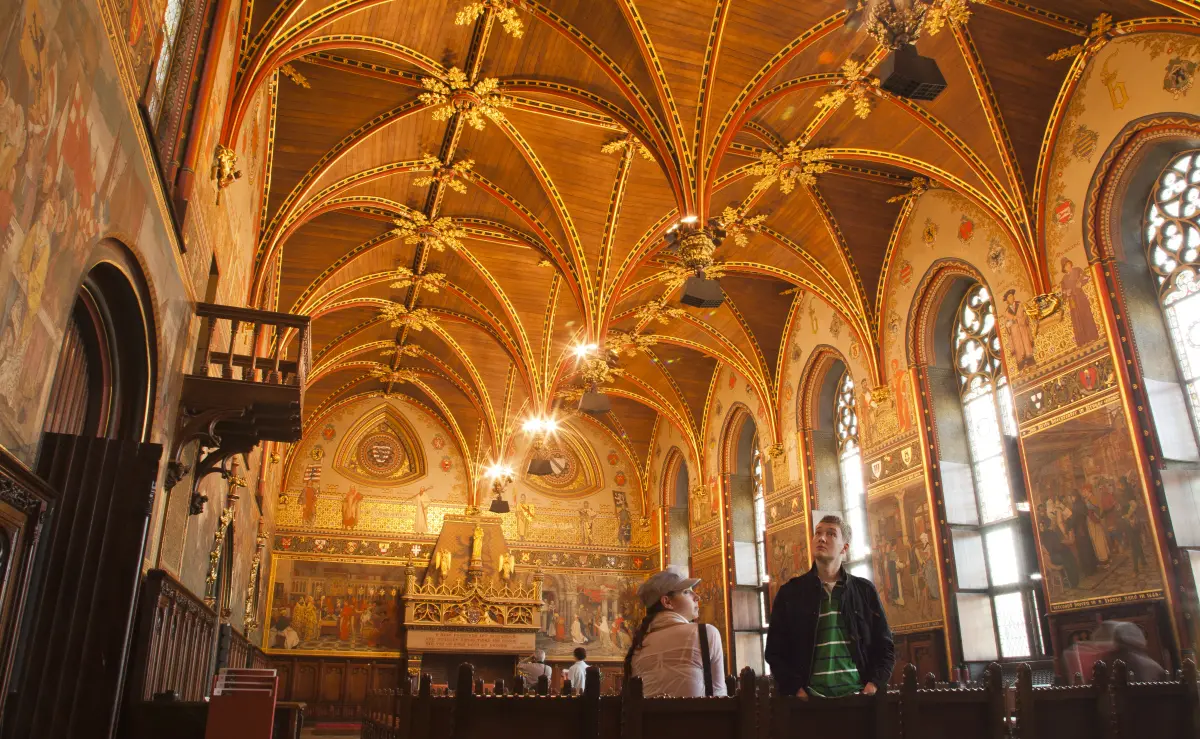
13 Liberty of Bruges
Contact details
Burg 11A8000 Brugge
Call 0032 50 44 87 11
E-mail musea@brugge.be
Visit www.museabrugge.be
Accessibility Liberty of Bruges
The entrance with its three steps is not accessible. Therefore, ask at the reception of the Liberty
of Bruges to put down a ramp. This ramp is very steep, so you will definitely need a strong companion to push you up.
The renaissance room with
its ornamental mantelpiece
is accessible without steps, although you may need some help to open the double door.
A free audio tour is available
for this hall in five languages
(NL FR DE EN ES) and can be followed with your own smartphone or tablet. By scanning QR codes you can
hear an explanation on your device. So be sure to take a headset or earphones along
with you. Please note: buy your tickets for the Liberty of Bruges
in the City Hall ![]() .
.
And off you go
At Burg Square, go through the archway between the Civil Registry and the City Hall directly into Blinde-Ezelstraat. This pedestrian street without obstacles is paved with level cobblestones. It emerges on
the Fish Market, which is also covered in flat mosaic cobblestones. Just before reaching the Fish Market, there are some benches in the Steenhouwersdijk from which you can enjoy
a lovely view. Turn 180 degrees and, with your back to the
Fish Market, turn left just
before reaching the water.
You end up on Tanners Square. Cross Tanners Square. You may need help to go up the slight slope towards Rosary Quay ![]() . Right in front you will find
a street called Pandreitje.
At Rosary Quay
. Right in front you will find
a street called Pandreitje.
At Rosary Quay ![]() , turn right and continue on the right-hand side. At Nepomucenus bridge,
at the junction with Wollestraat, you might need help in negotiating the tricky crossing with a kerb
, turn right and continue on the right-hand side. At Nepomucenus bridge,
at the junction with Wollestraat, you might need help in negotiating the tricky crossing with a kerb ![]() and slope
and slope ![]() .
Fancy a look in the photogenic Passage Bourgondisch Cruyce? Then, before crossing the
bridge, go right and follow Wollestraat. When you reach Kartuizerinnenstraat (left),
the Passage appears on
your right-hand side. Along
the way you pass restaurant Delicious
.
Fancy a look in the photogenic Passage Bourgondisch Cruyce? Then, before crossing the
bridge, go right and follow Wollestraat. When you reach Kartuizerinnenstraat (left),
the Passage appears on
your right-hand side. Along
the way you pass restaurant Delicious ![]() .
.
Return to continue the route towards the Dijver. Stay on the right in the Dijver. The smooth granite kerb ![]() slopes gradually downwards at the beginning of the Dijver.
slopes gradually downwards at the beginning of the Dijver.
14 Rosary Quay and Passage Bourgondisch Cruyce
If you want to make an impression on Instagram, you should definitely take some photos on Rosary Quay. This place was once called Salt Dike, because it is where ships moored to unload salt. In the 18th century, it was the place to be if you wanted to buy a rosary (paternoster), which explains the current name of the street. Today, it is one of the most beautiful cityscapes. Summer or winter, morning or evening, sun or rain, there is always romance in the air at Rosary Quay. Somewhat less familiar and quieter, but just as idyllic is the Passage Bourgondisch Cruyce. Those finding the passage (see ‘And off you go’), are rewarded by a fantastic view of the canals. So it’s worth the hunt!
Accessibility Rosary Quay and Passage Bourgondisch Cruyce
The footpaths in Rosary Quay and Wollestraat are made of level granite. Passage Bourgondisch Cruyce has a level surface.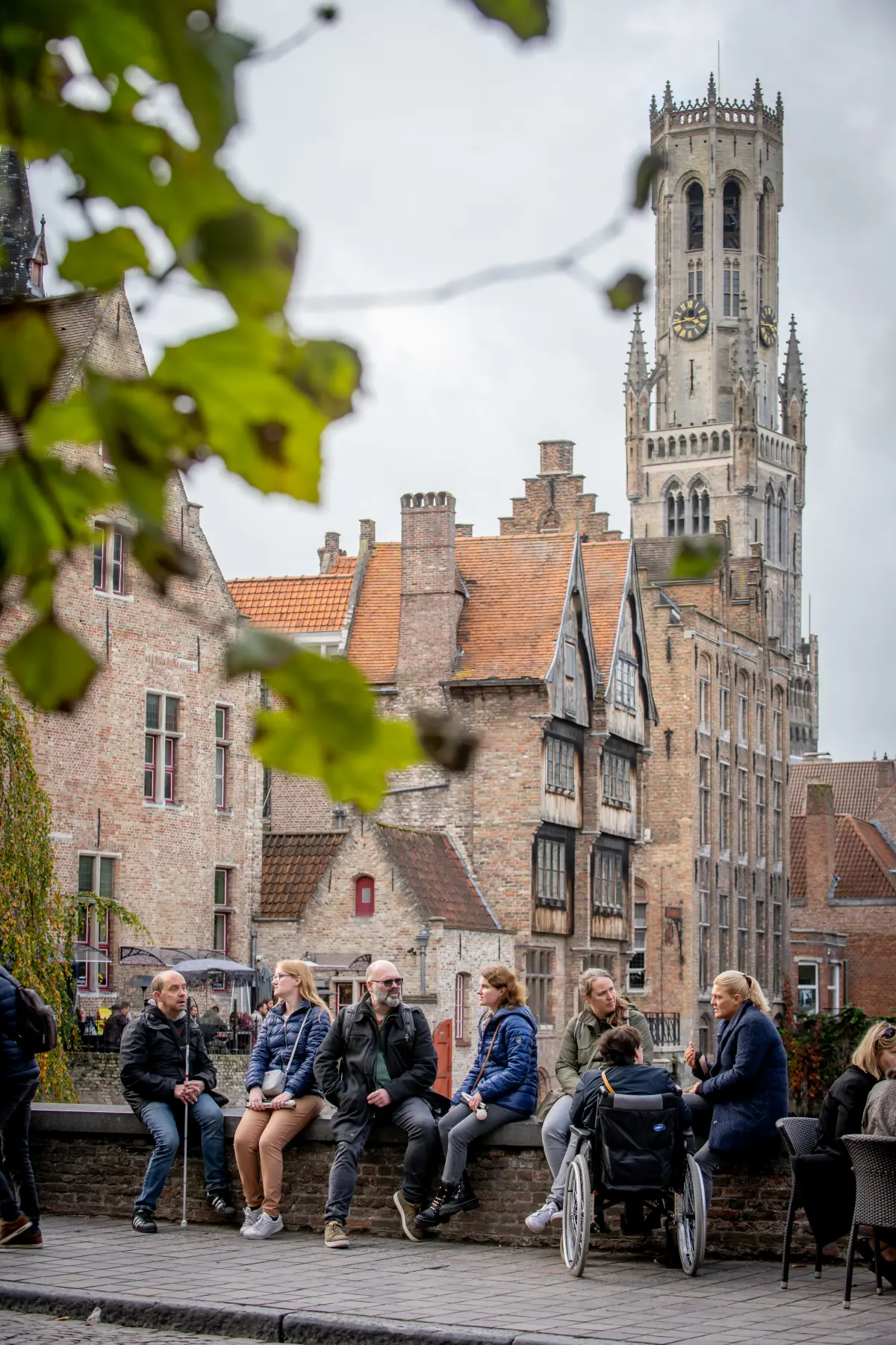
15 Dijver
Due to the absence of quay walls, this is the only place
in the city where the river Reie has preserved some of its natural appearance. Yet this canal is not called a ‘rei’ as most others are, but Dijver, which means ‘holy water’ in Celtic.
It is possibly the oldest place name in the city. Due to the presence of a forest of oak trees, the Celts most likely considered this spot along the water as
a sacred cult site. For the Celts, the oak was a sacred tree.
Today nature has made way
for culture and education,
as it now home to the famous
Groeninge Museum and College of Europe ![]() , a post-university course for students from all corners of the world.
, a post-university course for students from all corners of the world.
Accessibility Dijver
The path at the Dijver has
a semi-paved surface made
of dolomite. There is no border between the path and the water by the rows of trees. In the middle section, you will find various benches between
the trees.

And off you go
Keep going straight on along the Dijver. Almost at the end
of the row of trees, cross the street to go through the rococo gate to the Groeninge Museum ![]() , over a lowered kerb.
A flat cobblestone path guides you through the gardens of the museum to the entrance. In order to reach the entrance, you must first also negotiate
a short strip of difficult cobbles
, over a lowered kerb.
A flat cobblestone path guides you through the gardens of the museum to the entrance. In order to reach the entrance, you must first also negotiate
a short strip of difficult cobbles ![]() and a very steep slope
and a very steep slope ![]() made of chequer plate. Then, you end up at gate
that emerges on Groeninge street. Go straight across to reach a second gate in Hof Arents
made of chequer plate. Then, you end up at gate
that emerges on Groeninge street. Go straight across to reach a second gate in Hof Arents ![]() , a picturesque city park. Would you also like to visit the museum? In that case, after
the chequer plate, turn left
and the museum entrance
is directly in front of you.
, a picturesque city park. Would you also like to visit the museum? In that case, after
the chequer plate, turn left
and the museum entrance
is directly in front of you.
If you wish to avoid the chequer plate in the garden courtyard of Groeninge Museum, go past the rococo gate on Dijver and turn left
into the very next street, called Groeninge. A little further along on your left, you will find
the side entrance of the Groeninge Museum ![]() and, on
the right, the gate to Hof Arents
and, on
the right, the gate to Hof Arents ![]() . Hof Arents is close to Boniface Bridge we mentioned earlier.
. Hof Arents is close to Boniface Bridge we mentioned earlier.
16 Groeninge Museum
Contact details
Dijver 128000 Brugge
Call 0032 50 44 87 11
E-mail musea@brugge.be
Visit www.museabrugge.be
Accessibility Groeninge Museum
The museum entrance through the double door has no doorstep. All rooms are sufficiently large and easily accessible, only the slope to the museum shop and the first museum gallery is a little steep. The paintings are visible for everyone and the accompanying texts are legible. There is a free audio tour that you can follow using your own smartphone or tablet. By scanning QR codes you can hear an explanation (choice of NL FR DE EN) on your device. So be sure to take a headset or earphones along with you. Visitors with a visual disability can request an adapted guided tour. The route to the toilet and the adapted toilet itself are a squeeze. You will probably need some help in manoeuvring. A bracket is provided, but the basin is difficult to reach. At Guido Gezelleplein, less than 200 metres from the museum, there are two special parking bays. Those wishing to visit the courtyard garden as well should take account of the path of flat cobblestones and with a slope. You can avoid the slope by entering the garden using the side entrance in Groeninge street.
17 Hof Arents
Hof Arents is filled with a sense
of intimacy: greenery with secret benches in-between, a touch of art and a magnificent view of the Church of Our Lady ![]() and the Gruuthuse Palace
and the Gruuthuse Palace ![]() . At the beginning of the 20th century the city decided to purchase
the white classicist building, on the bridge linking the nearby Gruuthuse domain, with its 18th-century coach house and garden. The private garden became a public park.
In the garden you notice the
two pillars of the Water Halls,
a former maritime station with warehouse that once stood on the Market Square. The group
of statues ‘The Four Horsemen
of the Apocalypse’ by Rik Poot
is a chilling evocation of four abominations: Revolution,
War, Hunger and Death.
. At the beginning of the 20th century the city decided to purchase
the white classicist building, on the bridge linking the nearby Gruuthuse domain, with its 18th-century coach house and garden. The private garden became a public park.
In the garden you notice the
two pillars of the Water Halls,
a former maritime station with warehouse that once stood on the Market Square. The group
of statues ‘The Four Horsemen
of the Apocalypse’ by Rik Poot
is a chilling evocation of four abominations: Revolution,
War, Hunger and Death.
Accessibility Hof Arents
Hof Arents can be accessed without obstacles along wide paths of flat cobblestones. At the entrance gate on the side of Groeninge street there is a small drop in the doorstep. Within the small park, several paths are unpaved, however, they are all flat.
And off you go
Leave Hof Arents using the gate left of Bonifacius Bridge and
you end up back on Groeninge.
Go straight on and take the
first street to the right,
Kastanjeboomstraat,
which slopes upwards ![]() .
.
Would you prefer a shorter route? Then, turn right at the end of Kastanjeboomstraat
into Mariastraat ![]() .
Then you follow part of your earlier route, but in the opposite direction. A little further along Mariastraat, at the foot of the
Church of Our Lady, turn left
into Heilige Geeststraat.
At the end, turn left, into Sint-Salvatorkerkhof. Walk behind
St Saviour’s Cathedral, follow
the bend to the right and you end up back in Zuidzandstraat. Here, turn left, where you can return to the start of the walk,
at ’t Zand Square.
.
Then you follow part of your earlier route, but in the opposite direction. A little further along Mariastraat, at the foot of the
Church of Our Lady, turn left
into Heilige Geeststraat.
At the end, turn left, into Sint-Salvatorkerkhof. Walk behind
St Saviour’s Cathedral, follow
the bend to the right and you end up back in Zuidzandstraat. Here, turn left, where you can return to the start of the walk,
at ’t Zand Square.
If you wish to continue the walk, at the end of Kastanjeboomstraat, go left into Katelijnestraat. In this street, you will find the tearoom De Proeverie ![]() and the restaurant Less is More
and the restaurant Less is More ![]() . Cross diagonally in the direction of Stoofstraat, then turn into this street. Stoofstraat emerges on Walplein. Go immediately to the right-hand side of the square, then follow your route straight on, along
the footpath past Brewery
‘De Halve Maan’. You will need
to cross the road once in order to reach the footpath. The pavement has a small kerb
. Cross diagonally in the direction of Stoofstraat, then turn into this street. Stoofstraat emerges on Walplein. Go immediately to the right-hand side of the square, then follow your route straight on, along
the footpath past Brewery
‘De Halve Maan’. You will need
to cross the road once in order to reach the footpath. The pavement has a small kerb ![]() .
.
The middle section of Walplein
is difficult to access, because
the stones are very uneven ![]() . There are many unmarked terraces. Are you hungry or thirsty? You will find something
at Bistrobar Boreas
. There are many unmarked terraces. Are you hungry or thirsty? You will find something
at Bistrobar Boreas ![]() . Pass Brewery ‘De Halve Maan’ and,
at the end of Walplein, turn
right into Wijngaardstraat.
This brings you to Wijngaardplein, with its famous swans, and to the Beguinage
. Pass Brewery ‘De Halve Maan’ and,
at the end of Walplein, turn
right into Wijngaardstraat.
This brings you to Wijngaardplein, with its famous swans, and to the Beguinage ![]() .
Along the way you pass
the restaurants Tonka
.
Along the way you pass
the restaurants Tonka ![]() ,
La Dentellière
,
La Dentellière ![]() , Venezia
del Nord
, Venezia
del Nord ![]() and Maximiliaan
van Oostenrijk
and Maximiliaan
van Oostenrijk ![]() . If you fancy
an ice cream, don’t miss
a visit to Pralifino
. If you fancy
an ice cream, don’t miss
a visit to Pralifino ![]() .
.
Curious to discover an almshouse ![]() in Bruges? Then, at the end of Walplein,
continue straight on, into
Noordstraat. A few metres further on you will find almshouse de Vos on your right-hand side.
in Bruges? Then, at the end of Walplein,
continue straight on, into
Noordstraat. A few metres further on you will find almshouse de Vos on your right-hand side.
And off you go
The footpath on Wijngaardplein is covered with flat mosaic cobblestones which are uneven from time to time. At the water pump with horses’ heads, you can turn right to the main gate of the Beguinage ![]() . The Beguinage Bridge that leads
to the entrance has a steep slope
. The Beguinage Bridge that leads
to the entrance has a steep slope ![]() followed by a section
of round cobblestones
followed by a section
of round cobblestones ![]() .
.
Wheelchair users are
better off going straight on across Wijngaardplein towards
the Lock keeper’s house beside the Lake of Love ![]() . It is best to keep as far right as possible, close to the stones bordering the fence which protects the city’s swans. The cobbles are more even here than those in the middle. In this way, you have a flat path and can
easily reach the Beguinage.
If you fancy a rest, there
are some benches on the
left-hand side.
. It is best to keep as far right as possible, close to the stones bordering the fence which protects the city’s swans. The cobbles are more even here than those in the middle. In this way, you have a flat path and can
easily reach the Beguinage.
If you fancy a rest, there
are some benches on the
left-hand side.
Once you arrive at the Lock keeper’s house, turn right
and walk along the water,
and use the gate to enter
the Beguinage. Again,
the cobblestones ![]() are
round, however, you will
also find a comfort strip
in flat cobblestones.
are
round, however, you will
also find a comfort strip
in flat cobblestones.
18 Beguinage
Contact details
Begijnhof 24-28-308000 Brugge
Call 0032 50 33 00 11
E-mail liturgischcentrum@gmail.com
Accessibility Beguinage
The main gate at Wijngaardplein has a steep bridge. As an alternative, use the entrance
via the gate close to the Lock keeper’s house at the Lake
of Love. After the gate, turn immediately right. The entire inner circle of the Beguinage
is covered in flat and easy cobblestones. In order to reach this accessible path you must first cross some uneven cobblestones ![]() .
.
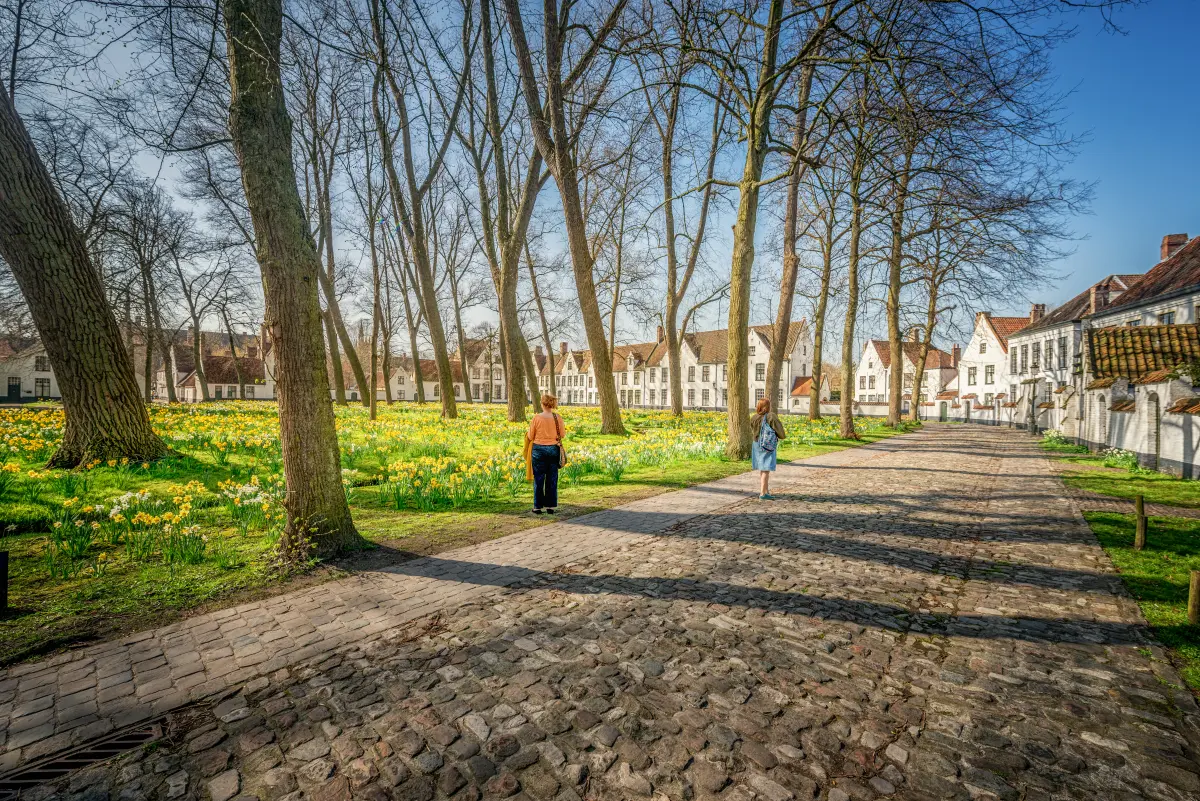
Towards the end of the walk
Leave the Beguinage through the gate at the Lock keeper’s house. Then, you have two options to go along the Lake of Love to the City Ramparts and complete the final section of the walk.
- Via Gunpowder Tower
After exiting the gate of the Beguinage , turn right immediately. Follow the path along the Lake of Love
, turn right immediately. Follow the path along the Lake of Love  until you reach the sturdy-looking Gunpowder Tower at the end, and then turn right. There is a slight slope
until you reach the sturdy-looking Gunpowder Tower at the end, and then turn right. There is a slight slope  . Follow the path across the City Ramparts
. Follow the path across the City Ramparts  and turn left at the end, into Oostmeers. Along the Lake of Love you will also find an adapted toilet
and turn left at the end, into Oostmeers. Along the Lake of Love you will also find an adapted toilet  .
. - Through Lake of Love Park
A alternative route takes you through Lake of Love Park. When you leave the Beguinage , go straight on, keeping the Lake of Love
, go straight on, keeping the Lake of Love  on your right. Cross Wijngaardplein and into Arsenaalstraat. Almost at the beginning of this street you will find the unpaved entrance to Lake of Love park. Go across the park to go up the City Ramparts
on your right. Cross Wijngaardplein and into Arsenaalstraat. Almost at the beginning of this street you will find the unpaved entrance to Lake of Love park. Go across the park to go up the City Ramparts  on the other side using a path that is accessible to wheelchairs. This path is very steep
on the other side using a path that is accessible to wheelchairs. This path is very steep  and can be slippery, so assistance will be required. Once you are on the City Ramparts, turn right and follow the path. There is an adapted toilet nearby
and can be slippery, so assistance will be required. Once you are on the City Ramparts, turn right and follow the path. There is an adapted toilet nearby  . Cross the Lake of Love bridge and be sure to stop and take in the view. Then, continue straight on, past Gunpowder Tower, until you reach Oostmeers, where you turn left.
. Cross the Lake of Love bridge and be sure to stop and take in the view. Then, continue straight on, past Gunpowder Tower, until you reach Oostmeers, where you turn left.
Regardless of whether you choose option 1 or 2, you will now see Bruges train station ahead of you. If you wish to return to ’t Zand Square, i.e.
the start of the walk, then cross the zebra crossing to the right and take the path through
the King Albert I Park ![]() .
.
19 Lake of Love
The mysterious atmosphere makes Lake of Love and its park the ultimate romantic hotspot. But what are the origins of the Lake of Love? To find out, we have to go back to the 12th or 13th century. At the point where a number of streams converged into the river Reie, to flow northwards through the city, the citizens of Bruges constructed a lock complex, making it easier to manage water levels in the river. And that’s how a dam and the Lake of Love were formed. The 16th-century Lock keeper’s house is on the exact site of the former locks. The eyecatcher on the east side of the lake is Castle de la Faille (19th century), built in neo-Gothic style by a Bruges city councillor. An ideal place to steal a kiss from your loved one perhaps?
Accessibility Lake of Love
Most streets and paths along the Lake of Love and in the Lake of Love Park are accessible and easy to navigate. There are many unpaved sections, but they are flat. Two lovely routes are described above.

20 City Ramparts
The City Ramparts are the largest protected cityscape in Bruges and form the perfect promenade. The park-like panorama was created in the 19th century, however, the City Ramparts date back to the second city fortifications from the 13th century. The population of Bruges was growing fast. Many, especially poorer people and religious communities, went to live outside the first city walls. As from 1275, the City of Bruges also expanded its official territory, but was still missing its fortifications. After the French king Philip IV the Fair occupied Bruges and saw the sorry state of the military lines in the city that had burst its seams, he ordered the creation of a new defences. It took about three years to complete the 6.8-kilometre-long ramparts. So, now you know how Bruges acquired its recognisable egg shape.
Accessibility City Ramparts
Ramparts
This section of the City Ramparts has a semi-paved surface in dolomite.
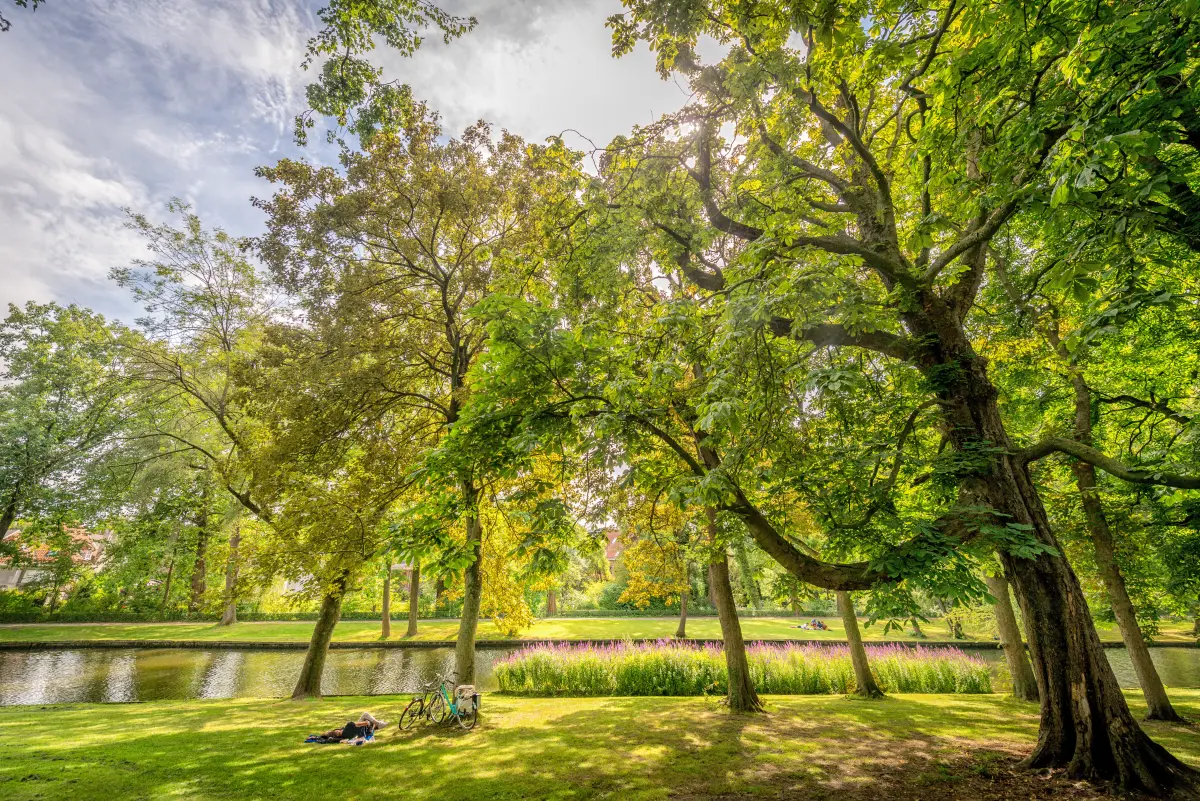
21 King Albert I park
There was a time when women spread out their linen here to bleach in the sun, but later, as from the 1830s, trains chuffed along their tracks towards the station. The tracks disappeared when the station moved from ’t Zand Square to the city perimeter. This space was almost used to build high-rise flats or a wide residential boulevard, however, the city council opted to create a landscape park to elegantly lead visitors into the city. In doing so, the city gained a new park. Slopes were created in the terrain to hide a series of shabby houses from view in the Westmeers. Some of these slopes were kept during the renovations in 2022. Need a break? Take a rest by the spots on the water at either end of the park.
Accessibility King Albert I Park
A path of smooth granite runs through the park. It is easily accessible and slightly sloping.
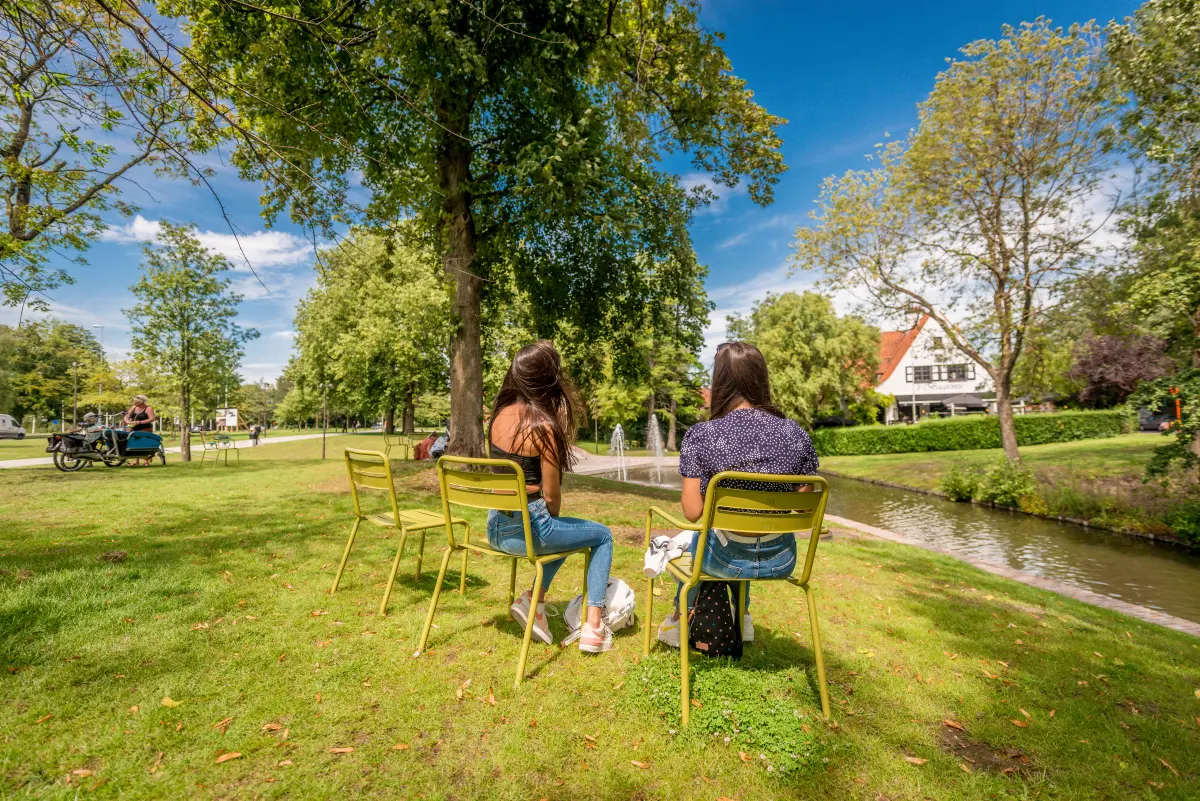
Close to the route, you will also find:
22 Bruges Royal Municipal Theatre
Contact details
Vlamingstraat 298000 Brugge
Call 0032 50 44 30 60
E-mail cultuurcentrum@brugge.be
Visit www.ccbrugge.be
Accessibility Bruges Royal Municipal Theatre
The municipal theatre is accessible using an alternative entrance along the side of the building in Adriaan Willaertstraat, via the ticket office. Throughout the building, you may need some assistance in opening double swinging doors. A lift in the building goes as far as balcony 2. There are two adapted toilets with rails on the ground floor. There are some special parking bays beside the municipal theatre and nearby.
23 Belgian Fries Museum
Contact details
Vlamingstraat 338000 Brugge
Call 0032 50 34 01 50
E-mail info@frietmuseum.be
Visit www.frietmuseum.be
Accessibility Belgian Fries Museum
The path leading to the museum is easily accessible. You may need a hand opening the door and negotiating the short steep slope at the entrance. Otherwise, the entrance is spacious, there is room to manoeuvre in the galleries and the floors are accessible by lift (110 by 124 centimetres). The passage to the lift on the ground floor is narrow, but functional. Some units and display cabinets are more challenging and less visible from a wheelchair, and the texts are sometimes too small. There is limited space in the adapted toilet, which prevents turning, however, there is room to line up beside the toilet bowl. There is only a bracket on the open side of the toilet bowl. Two special parking bays can be found in the area.
24 Lace Centre
Contact details
Balstraat 168000 Brugge
Call 00325033007
E-mail info@kantcentrum.eu
Visit www.kantcentrum.eu
Accessibility Lace Centre
On the path towards the entrance you need to cross some semi-repointed round cobblestones. The entrance, shop and other areas are easily accessible by wheelchair.
There is a lowered reception counter accessible to wheelchairs. A spacious lift with Braille indications takes you to all floors. In two places the lift buttons are more difficult to reach. The toilet has the necessary room to line up and includes brackets.
The experience elements are easily accessible and can be operated from a wheelchair,
and the exhibited objects and texts are easily visible, also thanks to mirrors in the lace-viewing cabinets. The film fragments have subtitles
and there is a feely box with different types of lace for
people with a visual impairment. The museum texts are available from the counter in large print
or can be sent by e-mail upon request. The centre also offers visits and workshops to suit people with a disability.


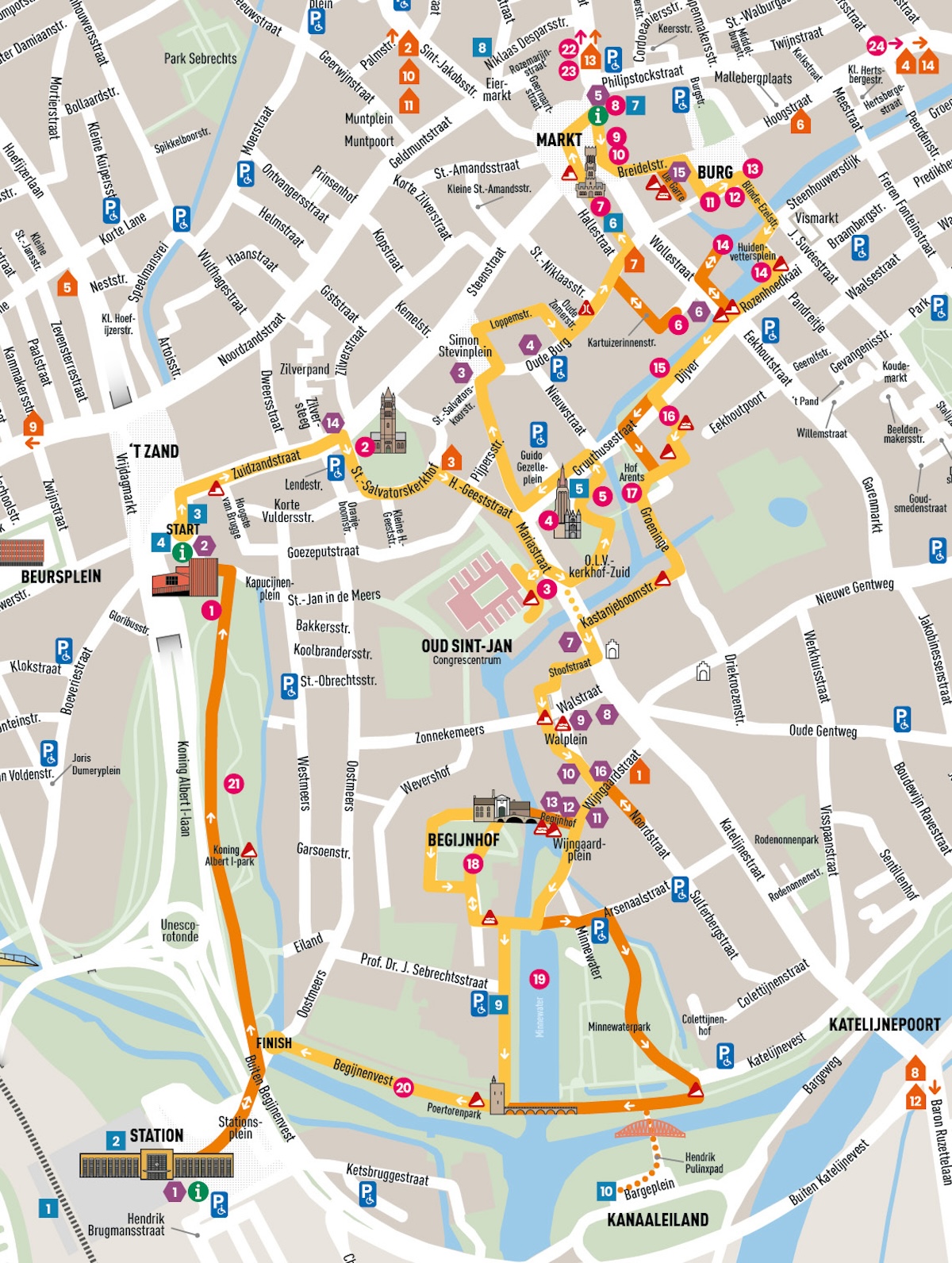
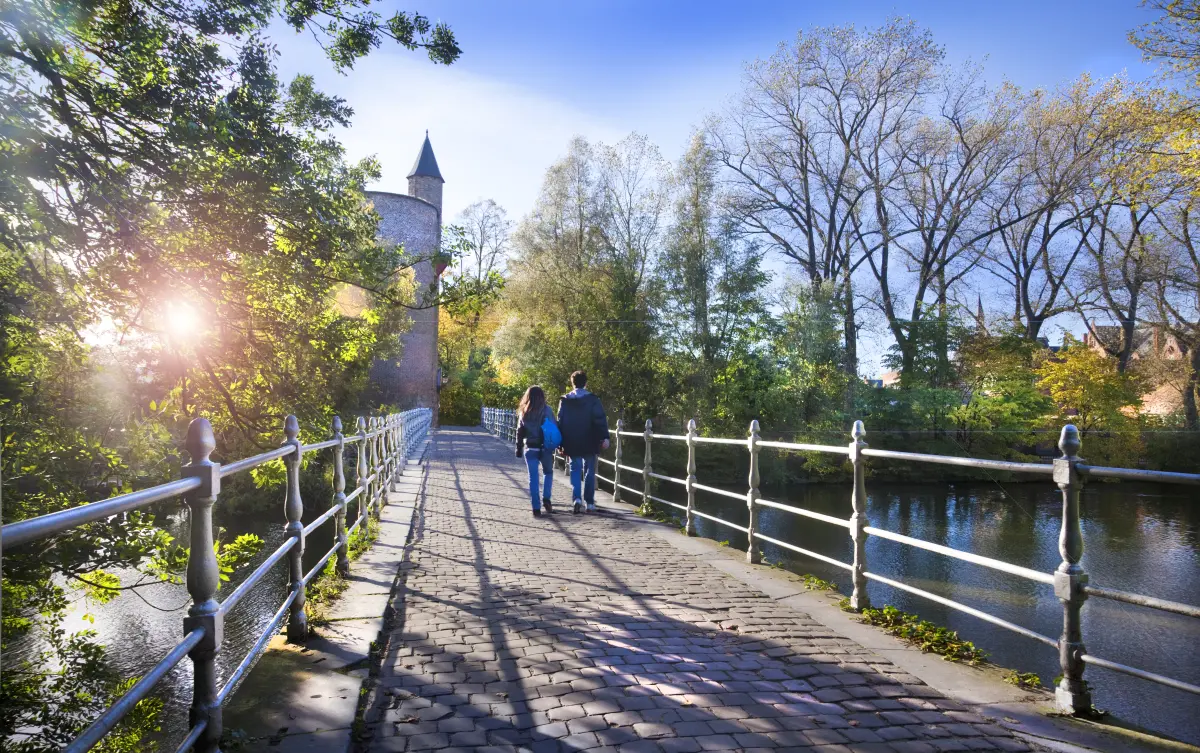
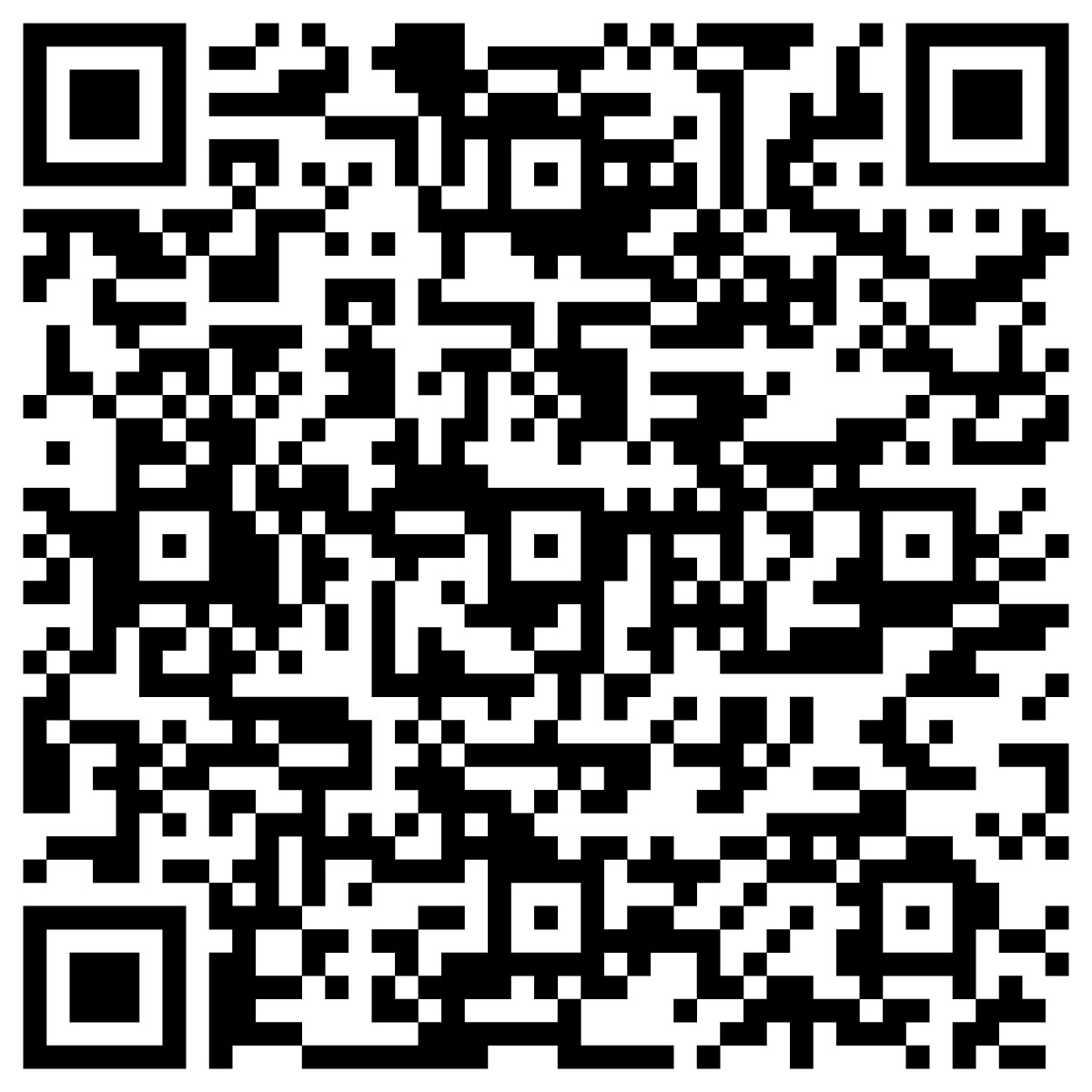

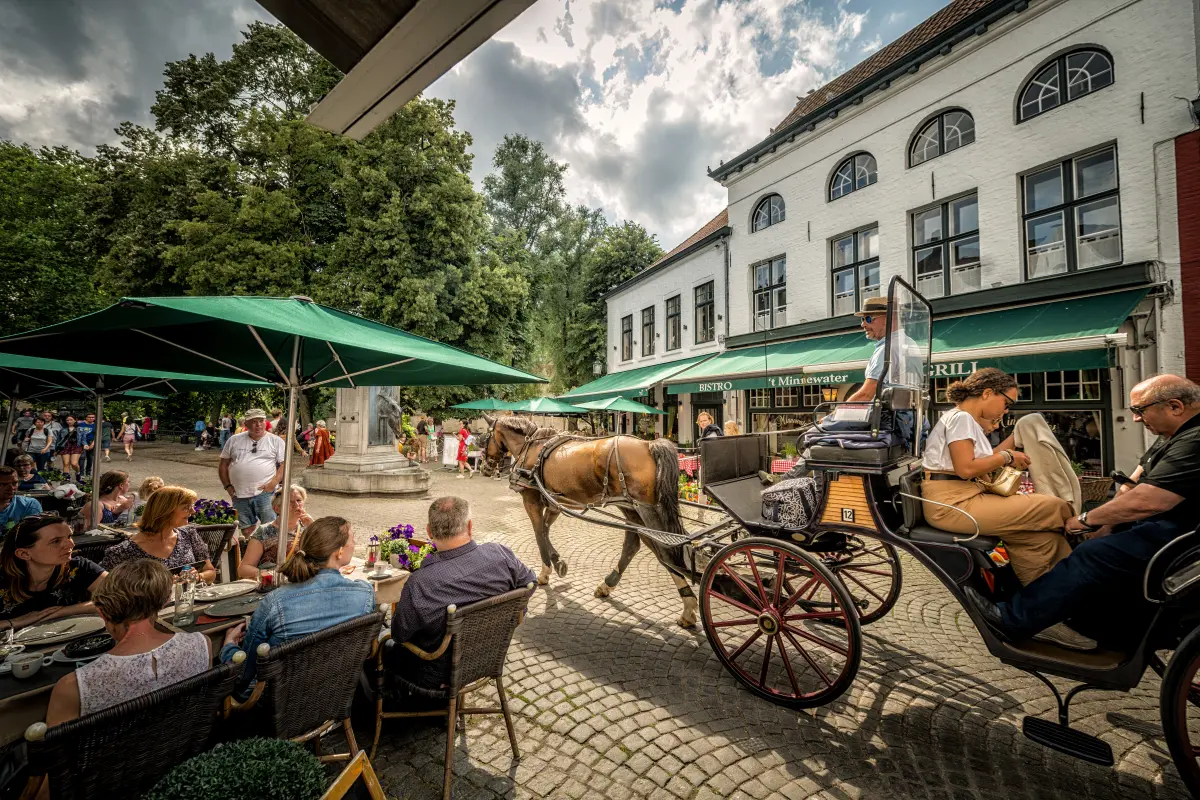
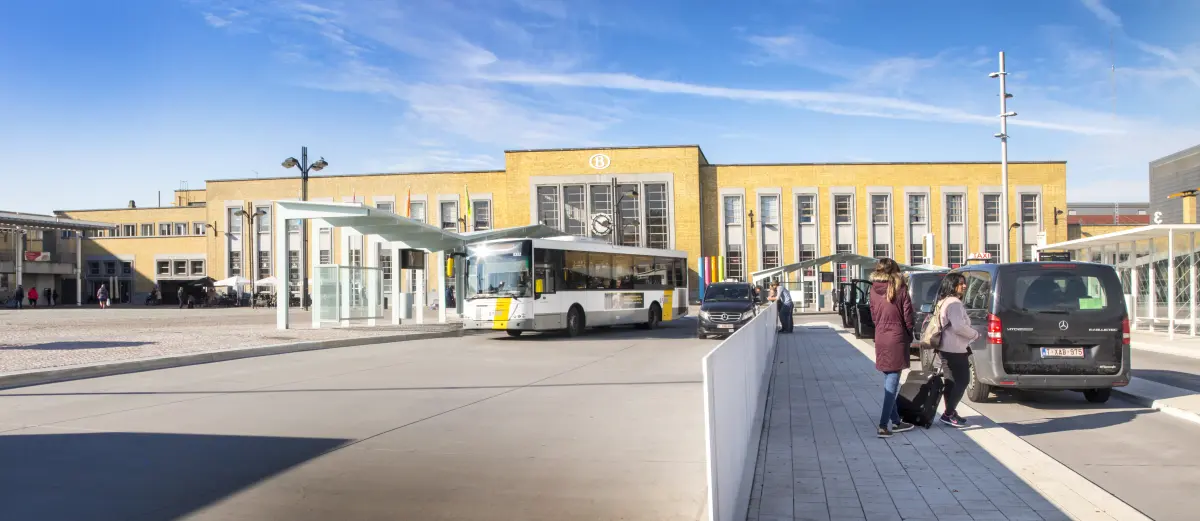
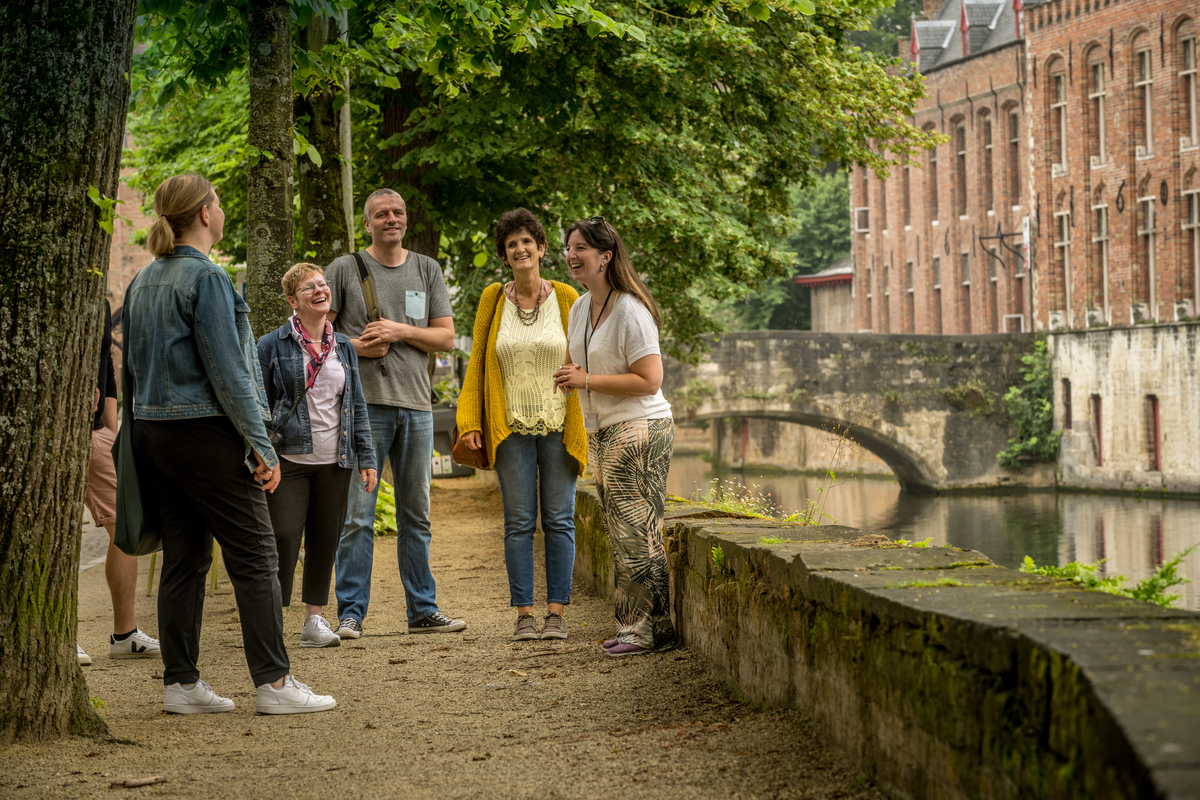
 You will find a spacious tourist office on the ground floor of
the Concertgebouw Brugge (Concert Hall)
You will find a spacious tourist office on the ground floor of
the Concertgebouw Brugge (Concert Hall)  If you are coming by public transport, the tourist office in
the station building is a perfect spot from which to start your exploration. You will find the office in the platform corridor, on the side of the centre. From here,
you can reach the historic heart of the city in the blink of an eye.
If you are coming by public transport, the tourist office in
the station building is a perfect spot from which to start your exploration. You will find the office in the platform corridor, on the side of the centre. From here,
you can reach the historic heart of the city in the blink of an eye.
 Historium Brugge
Historium Brugge 












